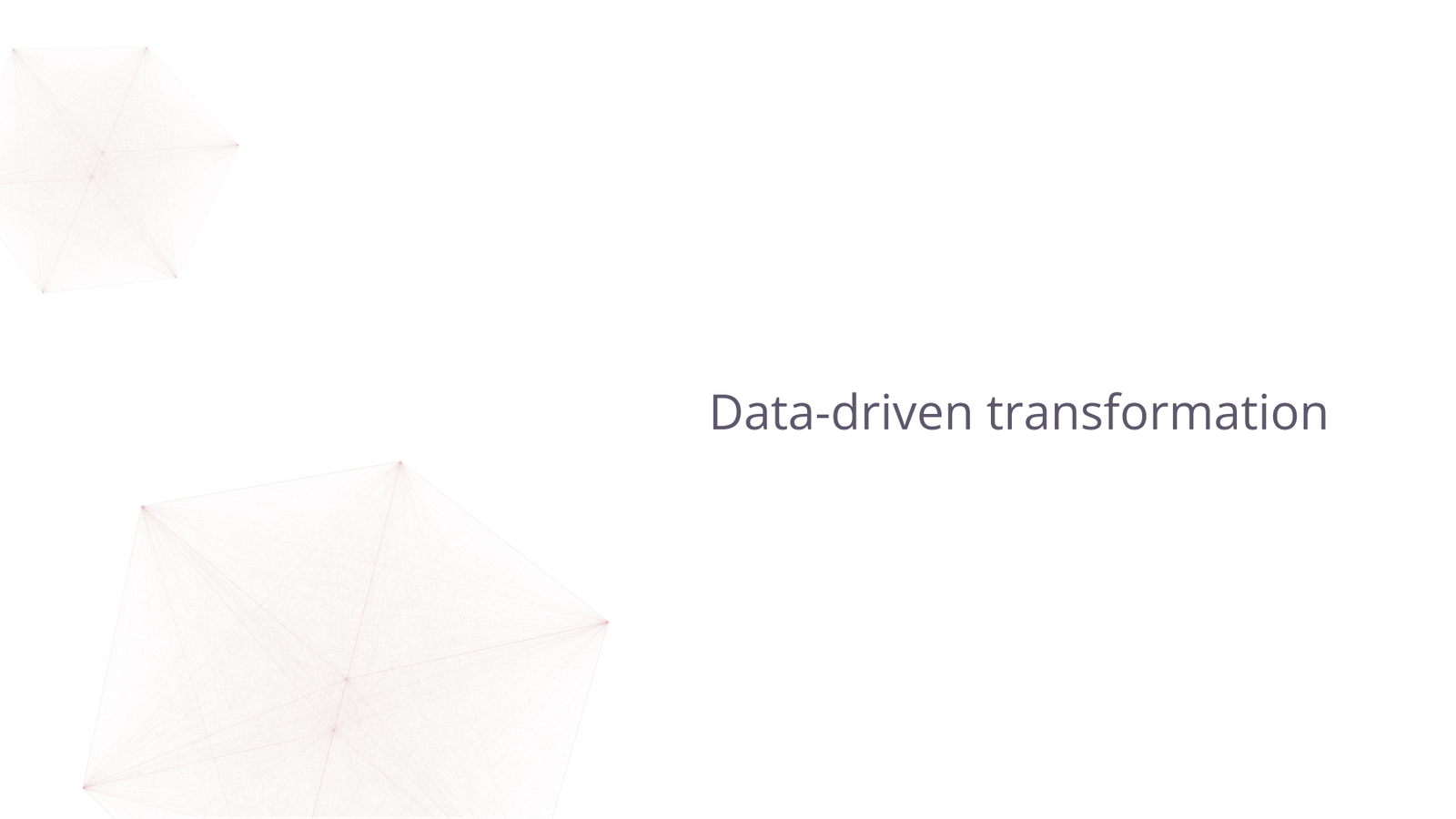MJ Lindeman, PhD, Community Partner
Jan 24, 2025

The data-driven transformation of an organization represents a fundamental shift in how businesses operate and make decisions. As companies embrace data-driven digital transformation, they’re moving from traditional “data-informed” thinking, where data is just another input, to true “data-driven” thinking, where analytics drive decisions unless there’s a compelling reason otherwise. This evolution fundamentally changes how organizations analyze information and create value through AI data transformation.
According to McKinsey’s 2024 Global Survey, this shift is driving real business impact. Nearly two-thirds of organizations surveyed are implementing AI digital transformation initiatives, almost double the adoption rate from a similar survey just ten months earlier. McKinsey reports, “Organizations are already seeing material benefits from gen AI use, reporting both cost decreases and revenue jumps in the business units deploying the technology.”
In the McKinsey survey results, 1,363 respondents reported the number of business functions in their organizations that had adopted AI. The numbers ranged from 8% for five or more business functions to 27% for three or more functions. The numbers for one and two or more functions were much larger.
This indicates that the adoption of AI within organizations is a systemic change rather than isolated experimentation. This rapid adoption reflects a growing recognition that staying competitive in today’s market requires more than just collecting data. It requires transforming how organizations use that data to make decisions.
The challenge: from data collection to actionable insights
While most organizations understand the importance of data-driven business transformation, many struggle with practical implementation. Traditional tools, particularly spreadsheets, have been the backbone of business analytics for decades. However, as IDC’s “Global DataSphere Forecast” (2023) reveals, the volume of data organizations need to analyze will more than double by 2027, far outpacing manual analysis capabilities.
This explosion of data presents both an opportunity and a challenge. The opportunity lies in the potential for AI-driven data analysis to uncover unprecedented insights. What is the challenge? It is developing a comprehensive data-driven transformation strategy that makes these insights accessible and actionable for everyone in the organization, not just data scientists.
Consider the typical challenges organizations must address when attempting to draw insights from their data:
- The data are scattered across multiple systems and formats.
- Many hours are spent manually cleaning and preparing data for analysis.
- The analysis methods used by different departments are inconsistent.
- There is limited collaboration between technical and business teams.
- There is difficulty scaling analytical capabilities across the organization.
- Delayed insights may come too late for effective decision-making.
AI-enhanced spreadsheets: bridging the gap
The concept of AI transformation is revolutionizing how organizations approach data analysis. Consider a typical monthly sales performance workflow. Traditionally, this process might consume a week of an analyst’s time. The required tasks include downloading data, cleaning it, analyzing it, creating visualizations, spotting trends, and responding to stakeholder questions.
Using AI-enhanced spreadsheets like Quadratic makes this entire workflow more efficient and effective:
- AI-Driven Data Visualization: The user can request a visual represenation of their data, and the AI chart generator will choose the most effective ways to present the information. The AI can format the details on a chart, such as slanting long labels, so that a screenshot can be pasted directly into a presentation.
- Intelligent Insights: AI and decision-making capabilities that automatically detect patterns, anomalies, and trends. The system can identify correlations and patterns that might take humans weeks to discover, if they find them at all.
- Natural Language Interface: Quadratic’s AI spreadsheet has tools designed specifically for AI data-driven decision-making. They allow users to ask questions in plain English, such as “What caused the spike in customer churn last month?” or “Which products are underperforming in the Northern region?”
- Collaborative Analysis: Team members can leverage AI for decision-making directly in the spreadsheet, with instant explanations of methodologies and calculations. This creates a shared understanding and enables more productive discussions about the insights.
These advantages are demonstrated in the short (30 seconds) warehouse tracking example at quadratichq.com. The user’s first request is to “Create a table showing the inventories of each item.” The AI creates the table and then, when a chart is requested, creates a bar chart placed next to the data. The user can request changes, such as sorted by descending quantity or slanting the long identifiers for the vertical bars.
The impact on decision-making
The real measure of success in data-driven transformation is its impact on organizational effectiveness. When companies successfully implement AI-enhanced analytics:
- Decision cycles shrink from weeks to hours.
- Teams focus on strategy rather than data preparation.
- Insights become proactive rather than reactive.
- Decision-making becomes more consistent and evidence-based.
Real-world impacts include:
- Faster response to market changes: Organizations can identify and react to shifting market conditions in much shorter time-frames. For example, a company can quickly respond to price changes by a competitor based on data rather than informed guesses,
- More accurate forecasting: By combining historical data with AI-powered predictive analytics, companies can generate forecasts that account for complex patterns and seasonality. This leads to inventory levels that better match actual demand and more precise revenue projections.
- Better resource allocation: Teams can optimize staffing, budget distribution, and project prioritization based on data-driven insights rather than gut feelings. This enables organizations to focus resources on the highest-impact activities and reduce waste in low-value areas.
- Improved customer satisfaction: Companies can identify and address customer pain points before they lead to churn. By analyzing patterns in customer behavior and feedback, organizations can proactively enhance their products and services to better meet customer needs.
- Reduced operational costs: Through better data analysis and process optimization, organizations can more quickly identify inefficiencies and streamline operations. This includes everything from supply chain optimization to quality control processes.
- Increased competitive advantage: Organizations can identify market opportunities faster and make more informed strategic decisions. This data-driven approach enables companies to spot emerging trends earlier and position themselves ahead of competitors.
Looking ahead
The path to data-driven transformation is no longer a distant aspiration but an immediate opportunity. As McKinsey's research shows, organizations are rapidly adopting AI-powered analytics tools, recognizing their potential to drive competitive advantage in an increasingly data-driven world. Three-fourths of the McKinsey 2024 respondents predict that generative AI “will lead to significant or disruptive change in their industries in the years ahead.”
Whether you’re just beginning your AI in digital transformation journey or looking to accelerate your existing analytics capabilities, the time to act is now. Tools like Quadratic offer a unique combination of familiar spreadsheet functionality and powerful AI capabilities, making advanced analytics accessible to everyone in your organization. The goal is a data-driven culture within the entire organization.
Ready to transform your organization’s approach to data analysis? Try Quadratic to see how our AI-enhanced features can transform your data workflows within minutes. Join the growing community of businesses that are reshaping their future through AI-powered analytics, and take the first step toward true data-driven transformation today.




